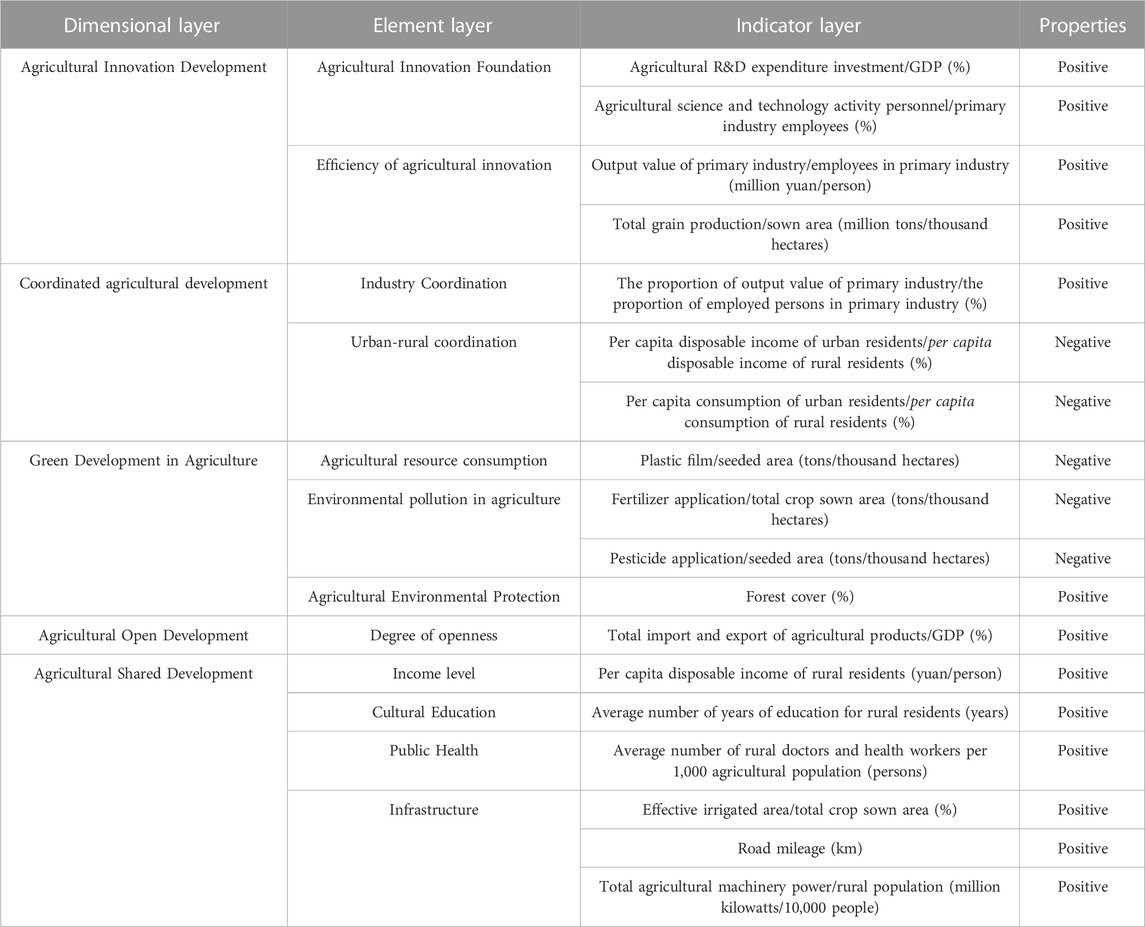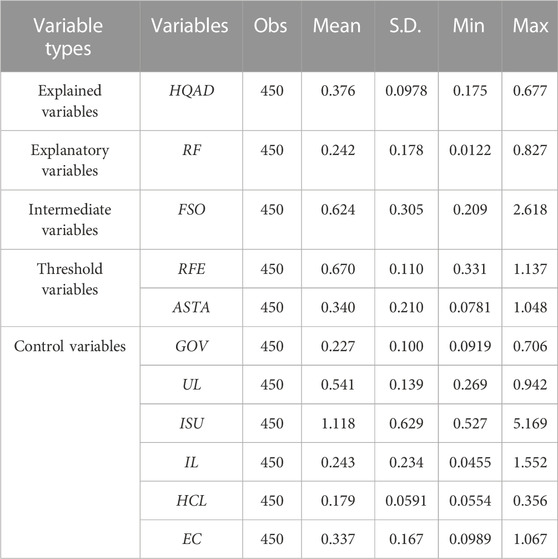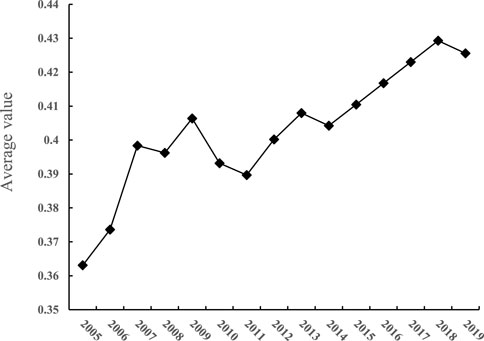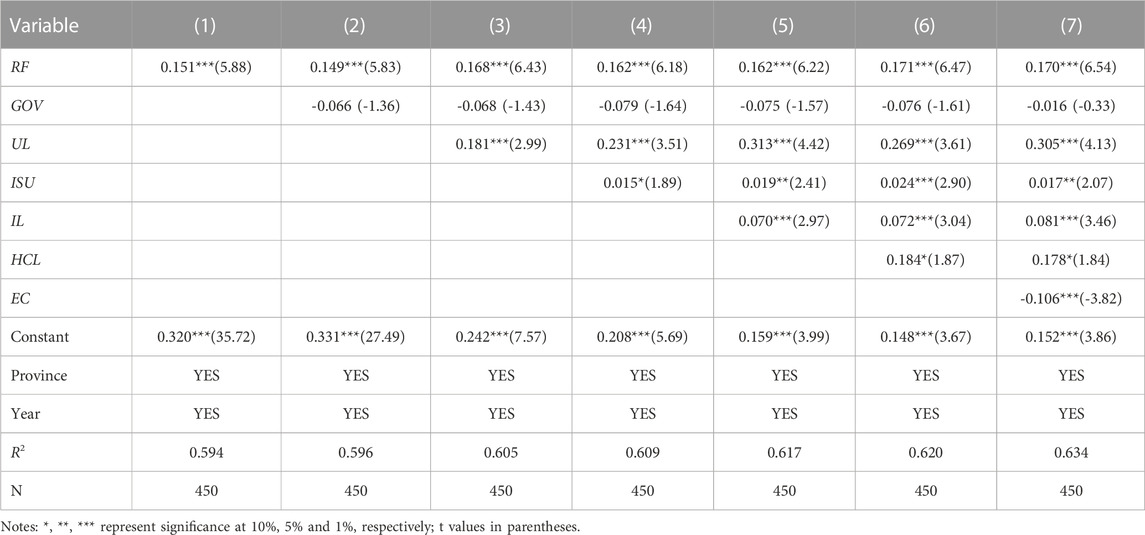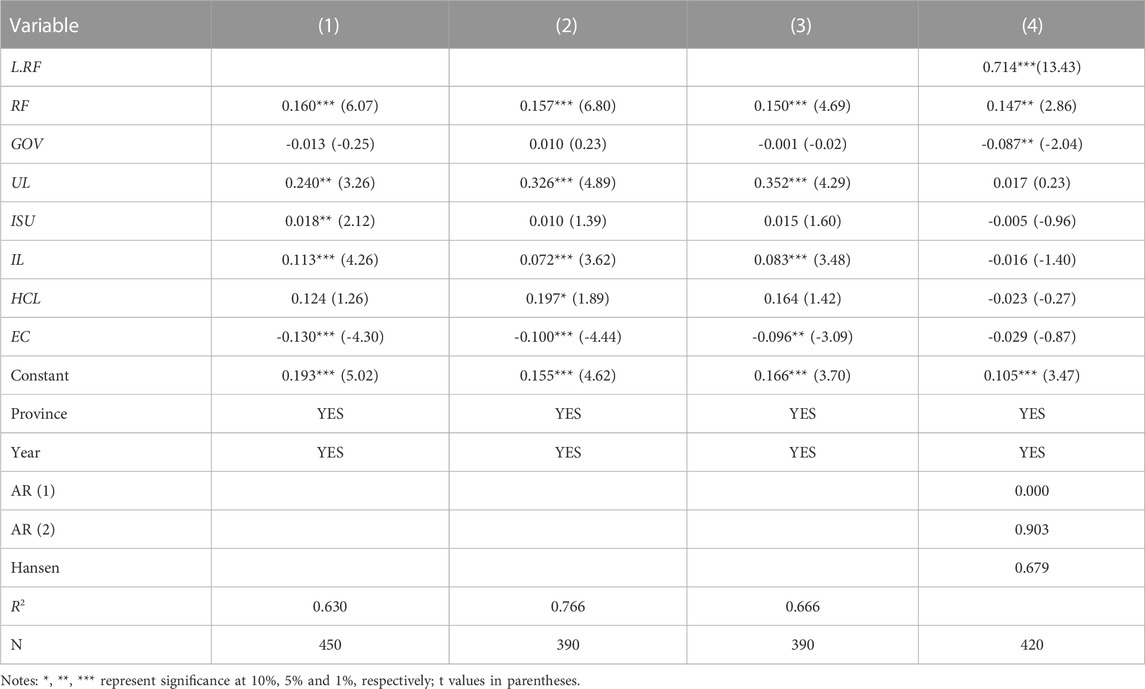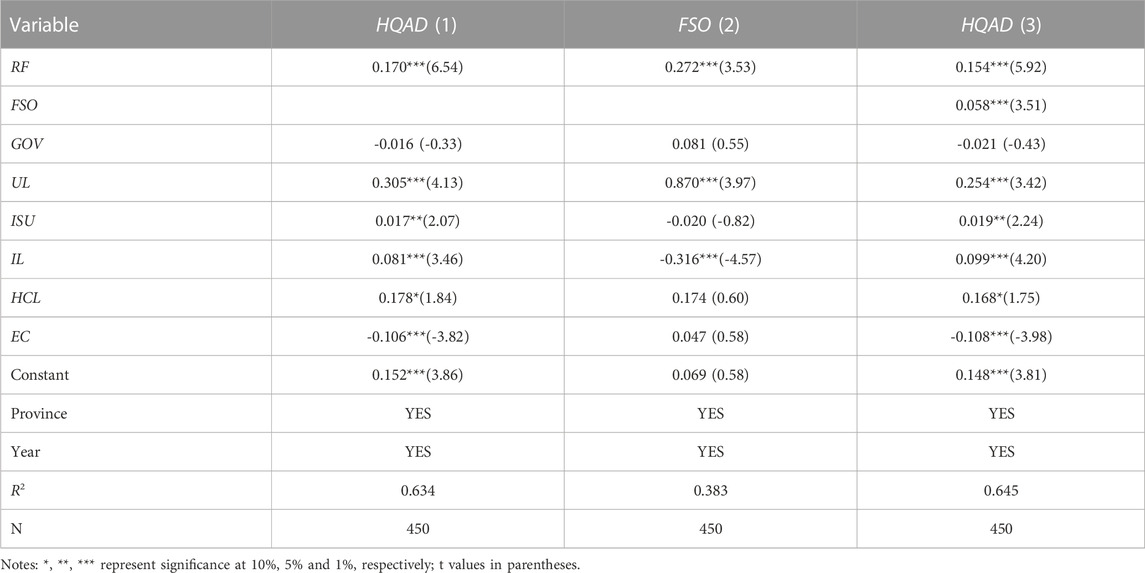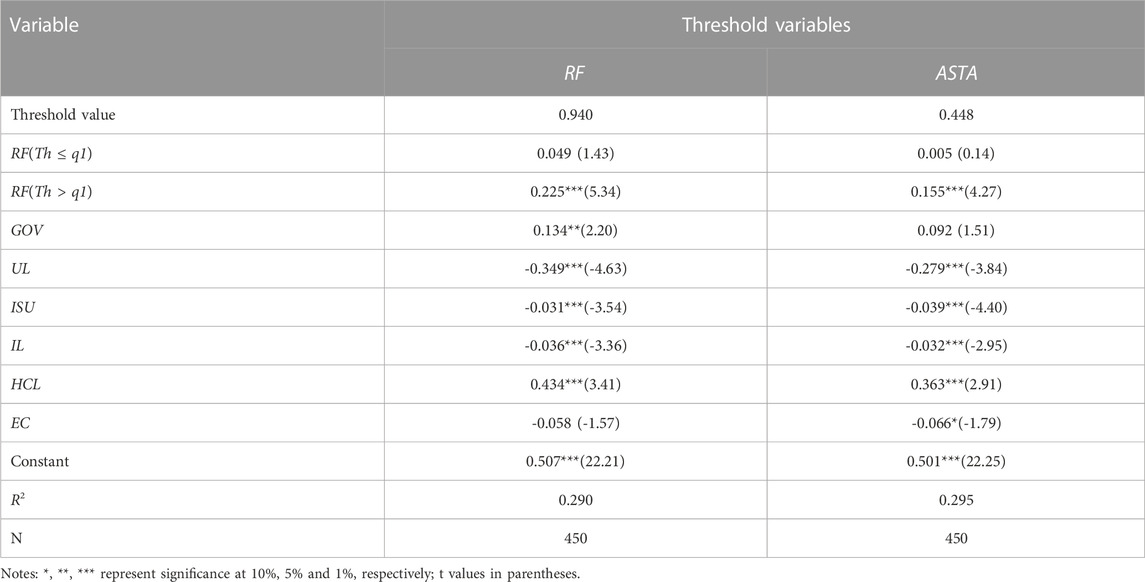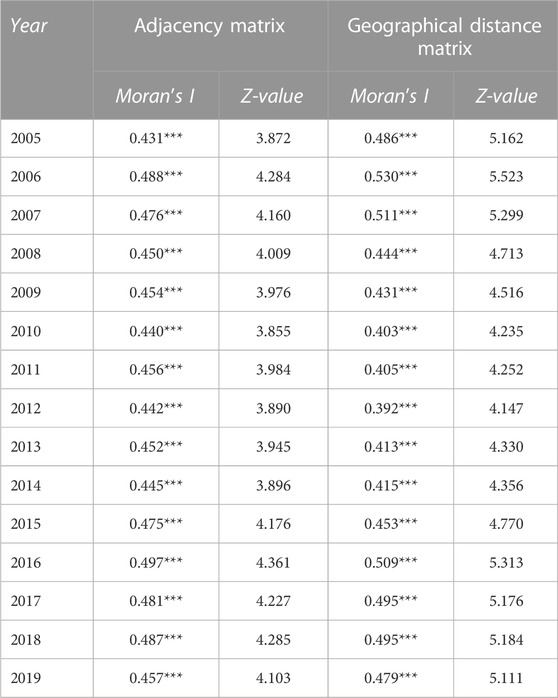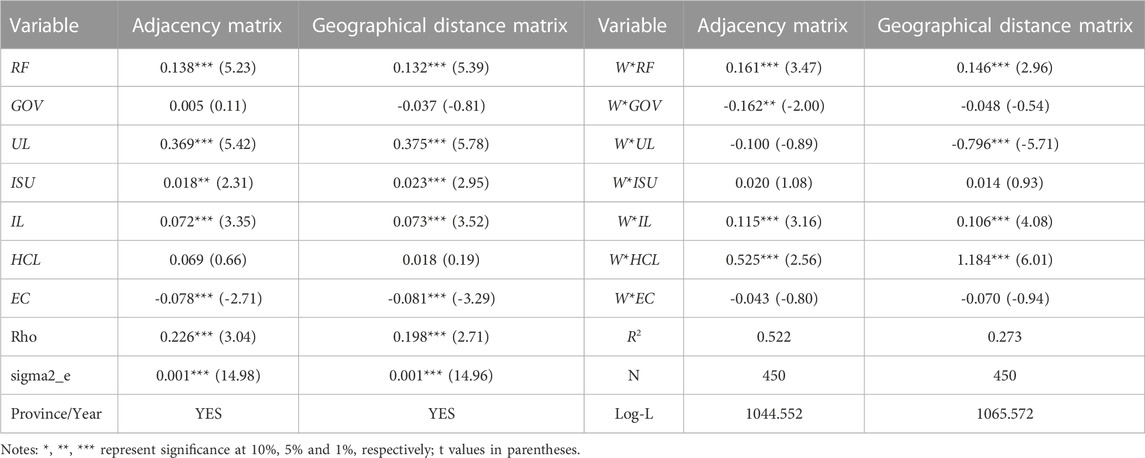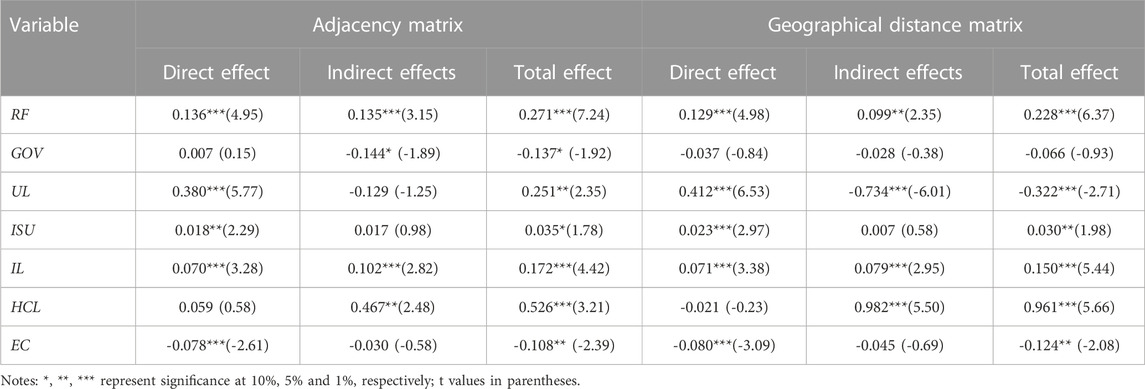- 1School of Economics, Central University of Finance and Economics, Beijing, China
- 2School of Economics and Management, Huaibei Normal University, Huaibei, China
- 3School of finance, Southwestern University of Finance and Economics, Chengdu, China
Achieving high-quality agricultural development (HQAD) has become an urgent and important task for many countries. This paper selects panel data of 30 provinces in China from 2005 to 2019 and uses the mediation model, panel threshold model and spatial econometric model to explore the impact of rural finance (RF) on high-quality agricultural development. The study found that: 1) RF can effectively promote high-quality agricultural development, and the conclusions still hold after multiple robustness tests; 2) The results of heterogeneity analysis show that RF has a significant role in promoting high-quality agricultural development during the period of high economic growth, and the effect is not obvious during the period of slow economic growth. In addition, under the conditions of heterogeneity of functional grain production areas and heterogeneity of financial literacy, RF has a significant positive effect on high-quality agricultural development, and the intensity of the effect is shown as main grain production areas > main grain marketing areas > balanced grain production and marketing areas, and higher financial literacy areas > lower financial literacy areas; 3) Farmland scale management plays a partially mediating role in the process of RF influencing high-quality agricultural development, and the share of the mediating effect in the total effect is 24.64%; 4) There is a single threshold effect of rural finance efficiency (RFE) and the share of agricultural technicians in the impact of RF on high-quality agricultural development, and the threshold values are 0.940 and 0.448, respectively. In the process of crossing the threshold, the enhancement effect of RF on high-quality agricultural development shows a marginal incremental feature; 5) There is a significant spatial correlation between China’s inter-provincial agricultural high-quality development, and RF in the region can act on the agricultural high-quality development of neighboring regions through spatial spillover effects. Our study enriches the existing literature and provides empirical evidence and policy insights on how RF in China contributes to high-quality agricultural development.
1 Introduction
Achieving high-quality agricultural development (HQAD) has become an urgent and important task for many countries. As the world’s largest and most populous developing country, China has created a world-renowned miracle by feeding 20% of the world’s population with 7% of the world’s agricultural land. However, for quite a long time in the past, the rapid development of traditional agriculture in China was at the cost of high energy consumption and high investment (Wu et al., 2020). This mode of agricultural production is unsustainable and even brings more serious environmental pollution problems. Therefore, it is necessary to change development ideas and models, and to accelerate the transformation of agricultural development from quantitative expansion to quality improvement. In 2018, China’s former Ministry of Agriculture clearly put forward that “China’s agriculture has entered a stage of high-quality development, and it should realize the transformation of agriculture from total volume expansion to quality improvement as soon as possible.” Consolidating the high-quality development of agriculture has become a necessary path to promote rural revitalization and accelerate agricultural modernization. In view of this, it is of great strategic significance to explore the dynamic mechanism and enhancement system of China’s HQAD and to contribute Chinese experience and solutions to other countries in the world.
As the core of modern economy, finance is the key driver to support the development of the “three rural areas”. However, for a long time China’s rural finance (RF) has been subordinated to the overall national industrialization strategy led by the Government. A large amount of rural financial resources have flowed to the cities and been converted into industrial capital, resulting in an insufficient scale of capital in rural areas. (Zhang and Wang, 2015). In response, the State has introduced a series of policy measures to implement rural financial deepening. Specifically, these include the comprehensive restructuring of rural credit cooperatives, the vigorous development of new types of rural financial institutions, and the promotion of reforms in land management right mortgages. The No.1 document of the Central Government in 2022 even listed “strengthening financial services for rural revitalization” as an important element for the first time, which also highlights the central government’s determination to solve the shortage of rural financial supply.
The existing literature on HQAD mainly focuses on indicator measures and impact factors. In terms of indicator measurement, there are still some disagreements on the evaluation of HQAD. Some scholars believe that the core of HQAD is to improve agricultural production efficiency. Based on this, early scholars used total factor productivity (TFP) to measure agricultural quality (Baráth et al., 2020; Reza Anik et al., 2020). With the concept of sustainable development, people began to pay attention to ecological environment and security issues (Streimikis and Baležentis, 2020; Xia et al., 2023). More and more scholars incorporated environmental resource constraints into the traditional TFP theory. Green total factor productivity (GTFP) became a measure of agricultural quality development and was widely used (Xu et al., 2020; Fang et al., 2021; Gao et al., 2022; Li et al., 2023); Another part of scholars believe that a single productivity indicator cannot accurately summarize the rich connotation of high-quality development, so a comprehensive evaluation index system is constructed to measure HQAD (Du et al., 2020; Baležentis et al., 2021; Lu et al., 2022). In particular, with the introduction of China’s new development concept, more scholars tend to construct and measure the indicators of China’s HQAD in five dimensions: innovation, coordination, green, openness, and sharing (Liu T. et al., 2020; Li and Xu, 2020). In terms of influencing factors, endogenous drivers include industrial structure adjustment (Wu et al., 2020), factor allocation optimization (Jin et al., 2018), and effective utilization of agricultural subsidies (Zhang et al., 2020); Exogenous drivers include foreign direct investment (Wang et al., 2019), new urbanization development (Liu J. et al., 2020), government policies (Qin et al., 2022a), and digitization of agriculture (Tang and Chen, 2022).
At present, there is not much literature on the relationship between RF and HQAD. The researches with high correlation mainly focus on the relationship between RF and agricultural economic growth. There are three main views: The first view is the “financial promotion theory”. Pagano (1993), based on banking data from 1961 to 2001 in India, finds that bank involvement in rural production can increase the income of the rural economy and alleviate poverty; Zamani and Tayebi (2022) argue that RF can efficiently allocate resources and promote economic development; Mei et al. (2022) found that the size and efficiency of rural finance favors rural economic growth. The second view is the “financial disincentive theory”, which is based on the theory of agricultural credit subsidies. In developing countries, government-led RF restrains the growth of agricultural economy (King and Levine, 1993; Liu et al., 2021). The reasons are as follows: due to the double influence of credit resource constraint and economic profit drive, a large number of financial resources transfer from rural to urban, resulting in the reduction of agriculture-related loans (Huang et al., 2006). In addition, the poor financial structure and low financial efficiency in rural areas also weaken the pulling effect of finance on the economy (Rousseau and Wachtel, 2011). A third view is the “financial futility theory”, which suggests that the simultaneous growth (or decline) of both may be a quantitative coincidence (Levine, 2003; Levine, 2005).
The existing literature has made a large contribution to the impact level of RF on agricultural economic growth, which has laid a solid theoretical foundation for the research of this paper. However, along with the arrival of the era of strengthening financial services for rural revitalization, there is still much room for deepening the research on the impact of traditional RF on HQAD. Compared with previous studies, the marginal contributions of this paper are mainly reflected in the following five aspects: First, it enriches the research on the economic effects of RF. Research on the economic effects of RF by scholars at home and abroad mostly focuses on rural economic growth. This paper explores the relationship between RF and HQAD and conducts quantitative tests; Second, it utilizes econometric models to reveal that the impact of RF on HQAD is characterized not only by direct effects and heterogeneity, but also by mediating effects. RF has a positive impact on HQAD by promoting the expansion of large-scale operation of agricultural land; Third, the use of the threshold model reveals that the impact of RF on HQAD is characterized by the non-linear feature of increasing marginal effect. In regions where the efficiency of RF and the proportion of agricultural scientific and technological personnel cross the threshold, RF has a greater role in promoting HQAD; Fourth, the use of spatial econometric models reveals the characteristics of the spatial spillover effect of RF on HQAD. RF not only has a positive effect on the high-quality development of agriculture in the region, but also can have a positive spillover effect on neighboring regions; Fifth, this study provides empirical evidence that RF contributes to the development of agriculture in China, and at the same time provides a reference for other countries with similar backgrounds.
2 Theoretical analysis and research hypothesis
2.1 The direct impact of RF on HQAD
The direct impact of RF on HQAD is mainly manifested in three aspects. First, the scale of credit for the “three rural areas” has been increased. First of all, it meets the demand of rural residents for production and operation loans, improves the income generating capacity of rural residents, enriches the channels for farmers to increase their income, and stimulates small farmers to operate on a proper scale and mechanization; Secondly, it helps the primary processing and deep processing of agricultural products through credit, supports small farmers to integrate into the agricultural industry chain, promotes the main body of the industry chain to stay in the countryside, and allows farmers to share more industrial value-added income. Second, innovation in financial products and service methods promotes HQAD. Finance meets the growing financial needs of agricultural enterprises by optimizing product types, improving service methods, increasing service coverage and improving product quality. In addition, innovative financial systems and products can help to break the liquidity constraints of farmers in the process of agricultural production, entrepreneurship and consumption. Third, the development of agricultural insurance drives HQAD. First of all, strengthen the publicity of rural insurance business and deepen farmers’ insurance awareness; Secondly, innovative agricultural insurance systems. On the one hand, vigorously promote the development of more mature types of insurance. On the other hand, new types of agricultural insurance have been introduced to meet the needs of agricultural and rural development; Finally, establish and improve the mechanism of catastrophe risk dispersion, implement the reserve system, and enhance the risk prevention and response ability of insurance institutions. Based on this, theoretical hypothesis one is proposed:
H1:. RF has a catalytic role in HQAD.
2.2 Indirect impact of RF on HQAD
Land is an irreplaceable means of production in agricultural production. In the context of the reform of China’s land system of “separation of three rights”, farmers’ enthusiasm for land transfer is increasing. Land transfer helps to scale up agricultural land operation, which plays an intermediary role in the process of RF influencing HQAD. Specifically, compared with the traditional family contracting system, intensive and large-scale production and operation improves agricultural production efficiency. However, for most farmers, the shortage of capital elements is an important factor limiting the large-scale operation of farmland. The development of RF provides direct financing channels for farmers to solve the capital shortage and meets the credit demand of farmers to expand farmland scale operation. In addition, with the deepening of the reform of China’s rural land system, the introduction of policies on the transfer of agricultural land has created conditions for the large-scale transfer of agricultural land. The rapid development of RF has increased the scale and stability of farmland transfer transactions and stimulated the maturation of the land transfer market (Luo et al., 2012). The increasing scale of farmland operations has contributed to the adoption of modern agricultural technologies and management methods. Large-scale operations help optimize the allocation of resources, increase labour productivity and promote high-quality agricultural development.
H2:. RF can indirectly promote HQAD by facilitating the expansion of farmland operations on a large scale.
2.3 The threshold effect of the impact of RF on HQAD
In the 1950s, academics began to pay attention to the role of financial development in guiding and promoting economic growth. Rural economic development requires a large amount of capital to promote. The rural financial system optimizes the allocation of rural capital through the mobilization of savings, which ultimately leads to economic growth in agriculture. In a real economy, the rate of rural economic growth depends on how much social savings flow to rural enterprises and farmers with high capital needs and high productivity. Different regions of China have very different levels of economic development, locational conditions, and policy orientations. In particular, the significant regional variability in the efficiency of RF has led to a heterogeneous impact of RF on HQAD. In general, the higher the level of rural finance efficiency (RFE), the easier it is for farmers to obtain loans at lower financing costs. The increase in loans to farmers provides the possibility of expanding the scale of farmland. Economies of scale raise the level of high-quality agricultural development; The lower the level of RFE, the poorer the capacity to absorb savings and lend money to the rural community. This severely constrains the ability of agricultural operators to access credit. Based on this, theoretical hypothesis three is proposed:
H3:. There is a threshold effect of RFE in the impact of RF on HQAD.Science and technology innovation is the core of HQAD. Among the many factors affecting agricultural science and technology innovation, the role of RF is more prominent (Xiao and Xu, 2012). However, constrained by the long-term lag in the development of RF in China, rural financial support for agricultural science and technology innovation is limited. As the level of RF increases, how to rationally and effectively utilize the efficiency of limited agricultural innovation funds, which requires the decisive role of agricultural scientists and technologists. Talents in agricultural science and technology help promote the integration of agriculture and science and technology, and promote the transformation and popularization of agricultural scientific and technological achievements. Therefore, when there are more people in agricultural science and technology activities in a region, the higher the efficiency of agricultural science and technology innovation invested by RF, and the stronger the positive effect on HQAD. Based on this, theoretical hypothesis four is proposed:
H4:. There is a threshold effect of the share of agricultural scientists and technicians in the impact of RF on quality agricultural development.
2.4 Spatial spillover effects of RF on HQAD
Anselin (1988) points out that economic phenomena in reality are characterized by spatial dependence or spatial autocorrelation. There is some degree of competition and cooperation in rural financial activities among regions. With the increasing degree of spatial correlation of RF, there is bound to be a certain degree of spillover effect on neighboring regions. On the one hand, HQAD has significant geographical characteristics. China’s vast territory makes the distribution of agricultural natural resources complex. Different agricultural production regions choose different types of crops to grow. Regional boundaries of production growing areas affect the geographic radius of HQAD (Norman and Castle, 1967); On the other hand, the spillover effect of financial literacy has led to an increasing degree of spatial financial linkages and interactions between regions. There is a natural advantage of rural financial spillover between neighboring regions. The central regions with a high level of RF drive the development of RF in the peripheral regions by setting up branches and sending technical and management talents to the peripheral regions. This in turn has a certain spillover effect on the HQAD of the neighboring regions. Based on this, theoretical hypothesis five is proposed:
H5:. RF can act on the HQAD of neighboring areas through spatial spillover effects.
3 Model construction, variable description and data sources headings
3.1 Model construction
3.1.1 Benchmark regression model
In order to analyze the impact of RF on HQAD, the following benchmark regression model is developed in this paper:
In Equation 1,
3.1.2 Mediating effect model
In order to test the indirect effect of RF on HQAD. Drawing on the mediation effect test proposed by Kenny (1986). The high-quality development of agriculture is taken as the explanatory variable, RF as the core explanatory variable, and farmland scale operation (FSO) as the mediating variable. The recursive mediation model is constructed as shown in equations 2–(4):
3.1.3 Panel threshold model
Consider that there is a threshold effect of RFE and the share of agricultural technicians on the impact of RF on HQAD. Further drawing on Hansen’s (1999) threshold effect test. RFE and the proportion of agricultural technicians as threshold variables, respectively. Construct a panel threshold effect model as shown in Equation 5:
In Equation 5,
3.1.4 Spatial econometric model
In order to explore the spatial spillover effects, the following spatial econometric model is constructed in this paper:
where
3.2 Variable selection
3.2.1 Explanatory variable: high-quality development of agriculture (HQAD)
According to the concept of high-quality development of Chinese economy in the new era, combined with existing studies (Hua et al., 2021; Qin et al., 2022b; Chen and Wang, 2022). This paper designs a comprehensive evaluation index system for HQAD in each province from five levels: innovation, coordination, green, openness and sharing. The specific indicators are shown in Table 1. On this basis, the entropy weight method is applied to measure the comprehensive index of high-quality development of Chinese agriculture, and the calculation steps are detailed in the Appendix.
3.2.2 Explanatory variables: rural finance (RF)
This paper constructs a RF evaluation index system that includes rural financial scale, rural financial structure and RFE. Among them, the scale of RF is measured by the ratio of rural loans to the total output value of agriculture, forestry, animal husbandry and fishery; the efficiency of RF is measured by the ratio of rural loan balance to rural deposit balance; and the structure of RF is measured by the ratio of rural enterprise loans to rural loans. Based on the hierarchical analysis method, the pairwise comparison judgment matrix and the relative weight vector among the indicators are obtained. Finally, based on the specific values and weights of the three indicators, the level of RF in each province was calculated.
3.2.3 Mediating variable: farmland scale operation (FSO)
The transfer of farmland is considered to be the inevitable way of agricultural scale management (Brümmer et al., 2006). Farmland scale management has become an inevitable trend of agricultural transformation and development. Along with the promotion of large-scale agricultural land management, the previous way of agricultural operation has been improved and the division of labor and cooperation within agriculture has become more reasonable. To a certain extent, the inefficiency of smallholder operation has been avoided and the cost of product production has been reduced (Otsuka et al., 2016), which is conducive to HQAD. In this paper, the ratio of crop sown area to agricultural workers in each province and city is used to measure farmland scale operations.
3.2.4 Threshold variables
Rural financial efficiency (RFE), which depends on the resource allocation function of the financial system (Ang et al., 2008), refers to the effectiveness of the conversion of savings to investment (Robinson, 1974). Rural financial inefficiency is a major obstacle to the development of China’s “three rural areas”. Drawing on the indicators commonly used by scholars, this paper adopts the ratio of rural loan balances to rural deposit balances; and the ratio of agricultural science and technology activities (ASTA), which is measured by the ratio of agricultural science and technology activities to the number of employees in the primary industry.
3.2.5 Control variables
There are many factors affecting the high-quality development of agriculture, and the control variables selected in this paper are mainly: Government intervention (GOV), measured by the proportion of government fiscal expenditure to GDP; Urbanization level (UL), measured by the proportion of urban population to total population in each province; Industrial structure upgrading (ISU), characterized by the ratio of added value of tertiary industry to added value of secondary industry; Infrastructure level (IL), measured by total post and telecommunications business per capita; Human capital level (HCL), characterized by the number of students in colleges and universities per 10,000 people in the region; Energy consumption (EC), energy consumption is the main source of carbon emissions in agriculture, which provides power support for HQAD while also brings a lot of pollution to agricultural development. This paper chooses per capita energy consumption as a representative indicator of energy consumption.
3.3 Data sources
Considering the availability and continuity of data, this paper selects panel data of 30 Chinese provinces from 2005 to 2019 (except Tibet, Hong Kong, Macau and Taiwan). The data come from China Statistical Yearbook, China Rural Statistical Yearbook, China Agricultural Yearbook, China Population and Employment Statistical Yearbook, China Financial Yearbook, EPS database, provincial statistical yearbooks and statistical bulletins of national economic and social development. Some missing data in some years were filled in by interpolation. The results of descriptive statistics of variables are shown in Table 2.
4 Analysis of results
4.1 Analysis of the measurement results of HQAD
Between 2005 and 2019, the quality of China’s agricultural development has generally shown an upward trend (Figure 1), with the index of HQAD rising from 0.363 in 2005 to 0.426 in 2019. This is closely related to the Chinese government’s efforts on the “three rural issues”. Since the No.1 Document of the Central Government returned to the “three rural areas” in 2004, China has introduced a series of policies to benefit and support agriculture and these initiatives have largely contributed to the high-quality development of agriculture. In addition, this paper adopts the method of systematic clustering (Q-type cluster analysis) to rank the level of HQAD in each province. The operation steps are as follows: (1) the comprehensive level of HQAD in 30 provinces of China from 2005 to 2019 was selected as the clustering index; (2) the Euclidean distance was used to measure the distance between the 30 samples; (3) the samples were categorized, and finally the clustering spectrum map of the level of HQAD in 30 provinces of China was obtained (Supplementary Figure S1).
Based on the results of the cluster analysis of HQAD system and ranked according to experience1, the 30 provinces were divided into four categories: agricultural high-quality regions, agricultural medium-high-quality regions, agricultural medium-quality regions, and agricultural low-quality regions. The results are shown in Table 3. It is found that the number of provinces of the first type and the fourth type is relatively small, with only Beijing in the former and Guizhou and Gansu in the latter. The second type of regional agricultural quality development has a higher overall score and ranking, including 10 provinces in Tianjin, Hebei, Liaoning, Jilin, Heilongjiang, Shanghai, Jiangsu, Zhejiang, Fujian and Shandong. This type of regional agricultural quality development has certain significance. Taking Shandong Province as an example, the improvement of Shandong’s agricultural development level mainly stems from three aspects: firstly, accelerating the construction of standard farmland and strengthening rural environmental improvement; secondly, improving the agricultural research system and enhancing agricultural production technology; thirdly, solidly promoting rural reform and introducing relevant policies in a timely manner. The third type of provinces mainly include 13 provinces in Shanxi, Inner Mongolia, Anhui, Jiangxi, Henan, Hubei, Hunan, Guangdong, Guangxi, Hainan, Chongqing, Sichuan, Yunnan, Shaanxi, Qinghai, Ningxia, and Xinjiang. With the advantages of location and policies, these provinces have been improving the level of HQAD and continuously narrowing the gap with developed provinces. However, such areas are generally significantly deficient in terms of quality control of agricultural products, optimization of industrial structure and technological innovation, etc. Therefore, it is necessary to clarify the development shortcomings and deficiencies, so as to lay the foundation for achieving further improvement in the level of HQAD.
4.2 Baseline regression results
This paper uses a two-way fixed effects model to estimate the baseline model. Table 4 reports the estimated results of the impact of RF on HQAD. Column (1) shows the regression results without adding control variables. The regression coefficient of RF is positive and significant at the 1% level. Columns (2) to (7) show the regression results after adding control variables step by step. The regression coefficients for RF are always significantly positive at the 1% level, indicating that RF significantly contributes to the improvement of the level of HQAD. The findings confirm Hypothesis one of this paper.
This paper uses the results in column (7) for the analysis. The regression coefficient for RF is 0.170, indicating that a 1% increase in the level of RF is associated with an average increase of 0.170% units in the agricultural quality development score. The average value of 0.376 for RF indicates that the scores for HQAD will differ by 0.064% (0.376% × 0.170%). As for the control variables: the regression coefficient of government intervention is negative, but not significant. For a long time, China’s agricultural development has been more concerned with whether there is a good harvest, which in fact means that it is more concerned with quantitative growth and neglects the improvement of quality; The increase in the level of urbanization has a positive impact on the high-quality development of agriculture. The enhanced urbanization will absorb the rural population and lay the foundation for agricultural scale operations (Wang et al., 2021). Meanwhile, the upgrading of residents’ consumption structure during urbanization can broaden the multifunctional demand for agriculture, which is conducive to improving the quality and efficiency of agricultural development; The upgrading of industrial structure significantly promotes the high-quality development of agriculture. Rationalization and advanced industrial structure can lead to continuous optimization and adjustment of the agricultural industry structure, which is conducive to farmers to obtain more value-added returns from the industrial; The regression coefficient of infrastructure is significantly positive. The continuously improving infrastructure level has laid a solid foundation for contributing to the high-quality development of agriculture. Promoting the modernization of agriculture and rural areas with the modernization of infrastructure can effectively contribute to the improvement of the level of HQAD; Human capital enhancement can help promote HQAD, and human capital investment can improve the quality of rural workers. At the same time, rural human capital, as one of the key factors driving the growth of TFP in agriculture, is a sure way to address the inefficiency of agricultural production and weak comprehensive agricultural production capacity; Per capita energy consumption has a significant negative impact on HQAD. This is because increased energy consumption generates large amounts of greenhouse gases and atmospheric pollutants, which is detrimental to GTFP growth in agriculture and inhibits high-quality agricultural development.
4.3 Robustness test and endogeneity analysis
In order to make the research conclusion reliable, the following methods are used to conduct robustness tests: First, the tailing process, with a two-sided 1% tailing process for all variables, was applied and the re-estimation results are presented in column (1) of Table 5; Second, municipalities directly under the central government are removed; Given the unevenness of China’s regional development, the special status and policy bias of municipalities directly under the central government may amplify the empowering effect of RF. Therefore, the sample of four municipalities directly under the central government, namely Beijing, Shanghai, Tianjin and Chongqing, are removed from the regression and the results are presented in column (2) of Table 5; Finally, adjusting the sample time span, in 2006, the “Agricultural Tax Law of the People’s Republic of China” was officially abolished, which improved farmers’ motivation to grow food and helped increase farmers’ income and increase agricultural inputs. Therefore, this paper selects the samples after 2006 for re-regression, and the results are shown in column (3) of Table 5.
In order to avoid possible reverse causality between the explanatory variables and the explained variables, as well as the possibility that the baseline regression may omit key explanatory variables. Therefore, this paper introduces lagged terms for the explanatory variables and uses systematic GMM estimation to overcome the endogeneity problem. The results are presented in column (4) of Table 5. It was found that the p-value of the AR (1) test was significant and the p-value of the AR (2) test was not significant, indicating that the endogeneity problem was overcome. The Hansen test values also indicated that there was no over-identification of instrumental variables, suggesting that the instrumental variables were chosen reasonably. In summary, the estimation results of multiple robustness tests are generally consistent with the results of the benchmark regression, indicating that the main findings of this paper have good robustness.
4.4 Heterogeneity analysis
1) Heterogeneity of economic growth phases: After the reform and opening up, China’s economy has maintained high growth. However, since 2012, due to the impact of the “three overlapping phases” of growth rate shift, structural adjustment pain period and the digestion period of the previous stimulus policies, the downward trend of the economy is obvious. Based on this, this paper divides the sample period into a high growth period (2005–2011) and a low growth period (2012–2019). The regression results are shown in columns (1) and (2) of Table 6. The results found that RF has a significant positive effect on HQAD in periods of high economic growth, while the effect of RF on HQAD is not significant in periods of slow economic growth. The reason: Generally speaking, the savings rate is proportional to the economic development rate. In addition, during the period of faster economic growth, investment in agriculture-related industries is active. The increase in the level of savings and investment facilitates the development of RF, which acts on rural areas and agriculture and promotes HQAD; Deposits taken by rural financial institutions from the countryside have grown slowly during periods of slower economic growth. The scale of financing for agricultural operators has been limited. It is not conducive to the expansion of the scale of agricultural operations, the upgrading of the level of agricultural mechanization, and the increase in agricultural science and technology inputs. As a result, the effect on the improvement of HQAD is not obvious.
2) Heterogeneity of functional grain production areas: According to the classification criteria of the National Medium- and Long-term Food Security Plan (2008–2020)2, China’s functional grain production areas are divided into main grain producing areas, main grain marketing areas, and balanced grain production and marketing areas. The regression results are shown in columns (3) to (5) of Table 6. The results found that RF is conducive to promoting HQAD in the main food-producing areas, the main food-selling areas, and the balanced food-producing and marketing areas. However, the intensity of the role of RF is shown as main food-producing areas > main food-selling areas > balanced food-producing and selling areas. The possible reasons are: in the main grain-producing areas, agricultural development and food security cannot be achieved without strong support from financial services. The development2 of RF is conducive to rural land transfer and agricultural technology progress, which has the greatest marginal effect on the quality and efficiency of HQAD; The main grain marketing areas mostly belong to economically developed areas, with stronger economic and financial strength. The marginal effect of RF is relatively lower; In the grain production and marketing balance areas, the encompassing provinces are mainly located in the western region. Limited by fragile ecological environment, backward infrastructure, low production efficiency, and slow technological progress and diffusion, the marginal effect of RF on HQAD is relatively weakest.
3) Financial literacy heterogeneity: financial literacy refers to the ability of individuals to access economic and financial information and to allocate assets accordingly. Differences in farmers’ financial literacy in different provinces may affect the role of RF in HQAD. Drawing on the methodology of Kennickell et al. (1997), education level is used as a proxy variable. The average number of years of education of rural residents in each province during 2005–2019 is taken as the mean value and ranked and grouped from low to high. The results of the grouping are shown in Supplementary Table S1. From the results in columns (6) and (7) of Table 6, it is found that RF has a significant positive effect on high quality agricultural development in both the higher and lower financial literacy groups. However, the intensity of the effect is higher financial literacy areas > lower financial literacy areas.
4.5 Mechanism test
Based on the above theoretical analysis, in order to test whether the scale operation of farmland assumes a mediating role in the process of RF affecting HQAD. The test is carried out according to the recursive mediation model of Eqs. 2–4. The results are shown in Table 7. The results found that the impact coefficient of RF in column (1) is 0.170 and is significant at the 1% level, indicating that there is a significant positive impact of RF on HQAD; The estimated results in column (2) found that the impact coefficient of RF on farmland scale operation is 0.272 and is significant at the 1% level. It indicates that the higher the level of RF, the more favorable it is to expand the scale of agricultural land management; Column (3) tests the intrinsic relationship between RF, farmland scale management and HQAD. The coefficients of RF and the mediating variable farmland scale management on HQAD are 0.154 and 0.058, respectively, both of which pass the 1% significance test. Thus, it can be seen that farmland scale operation assumes part of the mediating role in the process of RF influencing HQAD. The share of the mediating effect of farmland scale operation in the total effect is 24.64% (0.154 × 0.272/0.170). Therefore, hypothesis two is verified. In summary, it can be seen that RF provides financial support for agricultural development, promotes the expansion of large-scale management of agricultural land, and promotes HQAD.
4.6 Threshold effect analysis
First, the existence of the threshold and the number of thresholds need to be tested before the threshold regression. This paper applies Bootstrap sampling method. In the case of 300 times of sample self-sampling, the situation of using RFE and the share of agricultural scientific and technological activities personnel as the threshold variable is tested. The results are shown in Table 8. It was found that the F-statistics and p-values of the single threshold test results for RFE and the share of personnel in agricultural scientific and technological activities passed the significance test, but none of the double threshold effects were significant. It indicates that there is a single-threshold effect for both RFE and the share of personnel in agricultural science and technology activities. The threshold values for RFE and the proportion of personnel in agricultural science and technology activities are 0.940 and 0.448, respectively.
Second, the threshold regression results are analyzed to test hypothesis three and hypothesis 4. The results are shown in Table 9. Specifically, (1) The threshold variable is RFE: when RFE is ≤ 0.940, the regression coefficient of RF is positive but not significant; when RFE is > 0.940, the role of RF in enhancing high-quality development in agriculture is further enhanced and is significant at the 1% level. An increase in the level of RF per unit increases the agricultural high-quality score by 0.225 on average. The above results suggest that the enhancing effect of RF on HQAD has a marginal incremental character as the efficiency of RF increases. Increased RFE means that rural financial institutions have a greater capacity to convert deposits into loans. The greater the likelihood that rural households will have access to, receive and enjoy financial services. (2) The threshold variable is the share of agricultural technicians. When the share of agricultural technicians is ≤ 0.448, the average increase of agricultural quality development is 0.005 for each unit expansion of the share of agricultural technicians; When the share of agricultural technicians is > 0.448, the enhancement of HQAD by RF is significantly stronger. The coefficient value reaches 0.155 and is significant at the 1% level. The reason for this: HQAD must be based on agricultural science and technology innovation. The development of RF has provided financial support for the expansion of the scale of agricultural land management and the increase of agricultural science and technology inputs. Agricultural science and technology innovation needs to maximize the role of agricultural science and technology talents. Therefore, the higher the percentage of personnel in agricultural science and technology activities, the more favorable it is to improve the level of agricultural science and technology innovation. This in turn affects the high-quality development of agriculture. In summary, Hypothesis three and Hypothesis four are verified.
4.7 Spatial spillover effect analysis
Before parameter estimation of spatial econometric model, it is first necessary to confirm whether the explanatory variables are spatially correlated. Based on the adjacency matrix and geographic distance matrix, this paper adopts the global Moran’I index method for testing. The results are shown in Table 10. It can be found that the values of Moran’I index of high-quality development of agriculture from 2005 to 2019 are positive and all of them are significant at the 1% level. It indicates that the high-quality development of agriculture in each region has significant spatial correlation and obvious spatial agglomeration trend. Second, following the testing idea of Elhorst (2014), it went through LM test, Wald and LR test, and Hausman test in turn. The SDM spatio-temporal double fixed effects model is finally determined. The test results are detailed in Supplementary Table S2 and Supplementary Table S3.
To make the regression results robust and reliable, this paper conducts empirical tests based on the adjacency matrix and the geographic distance matrix, respectively. The results are shown in Table 11. The analysis is carried out with the results of geographic distance matrix estimation. The spatial autoregressive coefficient of high-quality development in agriculture is 0.198 and significant at 1% level. In addition, the coefficient of the spatial interaction term of RF (W*RF) is positive. It indicates that the sample provinces have not only exogenous interaction effects on RF in space, but also endogenous interaction effects on HQAD.
The value of the regression coefficient of the spatial interaction term in the spatial Durbin model cannot be directly used to discuss the marginal impact of RF on HQAD. Therefore, it is necessary to decompose the spatial spillover effects of RF. The decomposition results are shown in Table 12. In terms of the direct effect, local RF has a significant positive effect on local HQAD; In terms of indirect effects, the development of local RF has a strong spillover effect on the high-quality development of agriculture in other provinces; In terms of the total effect, RF significantly contributes to the improvement of HQAD. The above findings confirm the hypothesis five of this paper.
5 Conclusions and recommendations
5.1 Conclusion
As China’s economy shifts from rapid growth to high-quality development. Agriculture, as the foundation of the national economy, has also entered a stage of high-quality development that has shifted from output efficiency to quality efficiency. In this context, what is high-quality development of agriculture? What is the current status of high-quality development of agriculture in China? How to realize high-quality development of agriculture? The answers to these questions have important theoretical value and practical significance. Meanwhile, finance is the core of modern economy. As an important part of China’s financial system, RF has become a key driving factor in supporting the development of “three rural areas”. In this paper, RF and HQAD are included in the same research framework, and it is demonstrated that the impact of RF on HQAD has direct effects, heterogeneous characteristics, intermediary effects, threshold effects and spatial spillover effects. The main contributions of this paper: first, it enriches the research on the economic effects of RF. The research on the economic effects of RF by scholars at home and abroad mostly focuses on rural economic growth. This paper explores the relationship between RF and HQAD and conducts quantitative tests; secondly, the mechanism of the impact of financial development on rural economic development has been a hotspot of academic research (Zhao et al., 2014; Zakaria et al., 2019). This paper broadens the research in this field from the perspective of large-scale operation of agricultural land; thirdly, it is difficult to adequately explain the dynamic and non-deterministic relationship between RF and high-quality agricultural development in a linear model analysis framework test. Accordingly, this paper comprehensively examines the non-linear characteristics and spatial spillover effects of RF affecting agricultural high-quality development, which makes the research conclusions more comprehensive and scientific; fourth, this study provides empirical evidence that RF contributes to agricultural development in China. It also provides a reference for other countries with similar backgrounds. The findings of this paper are summarized below:
First, RF in China has a significant role in promoting HQAD. The conclusions still hold after various robustness tests; Second, from the point of view of heterogeneity, in the period of high economic growth, the role of RF in promoting HQAD is significant; in the period of slow economic growth, the effect is not obvious. In addition, the role of RF in promoting HQAD is very significant under the conditions of heterogeneity of food production functional areas and heterogeneity of financial literacy. The intensity of the role is as follows: main food production area > main food marketing area > balanced food production and marketing area, and higher financial literacy area > lower financial literacy area; Third, the scale operation of agricultural land plays a partly intermediary role in the process of RF positively influencing the high-quality development of agriculture. The share of the intermediary effect in the total effect is 24.64%; Fourth, there is a single threshold effect of RFE and the share of agricultural technicians in the impact of RF on HQAD. The threshold values are 0.940 and 0.448, respectively. In the process of crossing the threshold, as the level of RF increases, its enhancing effect on HQAD shows a marginal incremental characteristic; Fifth, there is a significant spatial correlation between interprovincial HQAD in China. RF in the region can contribute to high-quality agricultural development in neighboring regions through spatial spillover effects.
5.2 Policy recommendations
Based on the above conclusions, the following recommendations are made:
1) While speeding up the development of RF, we should focus on improving the efficiency of RF and cultivating agricultural science and technology personnel. It is difficult to rely on farmers’ own funds alone to support HQAD, so it is necessary to maximize the support of financial resources and focus rural financial services precisely on the “three rural areas”. First, by increasing the coverage area of rural financial institutions, we support and encourage financial institutions to sink their outlets to towns and villages to solve the problem of the “last mile” of financial services. In addition, vigorously develop new rural financial institutions, such as village banks, mutual fund societies, microfinance companies, China Postal Savings Bank, etc. Lower the threshold of agriculture-related loans to meet the loan needs of agricultural production operators; Second, take policy banks as the main body, backed by policy agricultural insurance, to build a policy-based financial support system for agriculture. Promote the return of rural financial institutions to their roots, and encourage the allocation of rural financial resources to rural economic and social development and key areas. At the same time, strengthen the application of digital technology in the field of RF. Utilizing digital platforms to form a digital agricultural finance development model that organically combines online and offline, easing the information asymmetry between farmers and rural financial institutions, and promoting the efficiency of RF. In addition, importance must be attached to the training of various types of talents in the field of agriculture. By improving and perfecting the training system for agricultural talents, implementing the project to improve the quality of grass-roots agricultural technicians and training high-quality farmers, we will help the high-quality development of agriculture.
2) Strengthen rural financial support and promote large-scale operation of farmland. There is a significant mediating effect of farmland scale management in the process of RF influencing HQAD. Therefore, to promote HQAD, it is necessary to promote large-scale farmland management. Land transfer is an important way to promote the large-scale operation of agricultural land, so it is necessary to improve the institutional mechanism of agricultural land transfer. First of all, we will innovate the forms of land transfer and encourage contracted farmers to transfer contracted land by means of subcontract, lease, exchange, transfer and investment. Second, to increase the transfer of agricultural land policy support. Specifically, it includes: increasing the subsidies for the transfer of agricultural land, giving subsidized loans or short-term interest-free borrowing policy support to large transferring households, and actively exploring the transfer of land management right mortgages and so on.
3) Adhere to the concept of synergistic development and strengthen inter-regional cooperation and integration. The research results show that the Moran index of China’s HQAD was significantly positive during 2005–2019, indicating that the HQAD of each province has significant spatial correlation. Therefore, in the process of formulating agricultural development planning, provinces should strengthen cooperation and exchange with neighboring regions in agricultural development. In addition, RF has significant spatial spillover effects on HQAD; Therefore, attention should be paid to the coordinated development of RF between regions. On the one hand, through tax incentives, loan subsidies and the establishment of agricultural funds, rural financial institutions such as agricultural credit cooperatives are guided to increase credit resources and reduce the cost of loans for farmers; On the other hand, popular education on rural financial knowledge should be enhanced to improve the financial literacy of agricultural operators.
5.3 Limitations and future prospects
Due to the limitations of the research conditions, some aspects of this paper still need to be further improved in future research. Firstly, the connotation definition of HQAD has not yet formed a consensus. The construction of its indicator system has distinctive characteristics of the times. In the future, we need to reconstruct the comprehensive evaluation index system and measure it in conjunction with the goal of HQAD in the new era; second, we are limited by the lack of statistical data, which makes it impossible for us to analyze the research topic in depth from prefecture-level cities or smaller spatial units. In future research, in order to make the conclusions of the study more policy-referenced, the research sample can be narrowed down to the main provinces of China’s agricultural cultivation, thus obtaining all kinds of data needed for the study, so as to more accurately analyze the impact of RF on the high-quality development of agriculture; thirdly, when examining the impact of RF on the high-quality development of agriculture, the mediation path selection is relatively narrow, which may lead to bias in the analysis of the mechanism and insufficiency. In the future, more aspects should be considered; fourth, this paper mainly analyzes empirically from the macro level, and in the future, quantitative tests can be conducted from the micro level, which may lead to more exciting research results.
Data availability statement
The data analyzed in this study is subject to the following licenses/restrictions: available only for apply. Requests to access these datasets should be directed to MTE0NTc2ODQ0MUBxcS5jb20=.
Author contributions
CH designed the study and participated in the revision of the manuscript. NB wrote the first draft of the manuscript. QZ was responsible for sampling and data analysis. All authors contributed to the article and approved the submitted version.
Funding
This research was funded by the National Natural Science Foundation of China under the project “The Impacts of Energy Price Fluctuation, Investment in Information Technology and Technological Progress on China’s Low-Carbon Economic Growth: A Study Based on the Linkage Model of IGEM and Microsimulation”, grant number “71573291”; National Social Science Foundation of China Major project “Research on Optimization and Reform of Tax Structure for Promoting High-Quality Economic Development”, grant number “21&ZD096”.
Conflict of interest
The authors declare that the research was conducted in the absence of any commercial or financial relationships that could be construed as a potential conflict of interest.
Publisher’s note
All claims expressed in this article are solely those of the authors and do not necessarily represent those of their affiliated organizations, or those of the publisher, the editors and the reviewers. Any product that may be evaluated in this article, or claim that may be made by its manufacturer, is not guaranteed or endorsed by the publisher.
Supplementary material
The Supplementary Material for this article can be found online at: https://www.frontiersin.org/articles/10.3389/fenvs.2023.1217422/full#supplementary-material
Footnotes
2China«s HQAD is in the initial stage of transformation, and the selection of indicators and system construction are still being explored, but the classification of grades in various literatures has certain practical significance.
2grain production areas including Hebei, Inner Mongolia, Heilongjiang, Jilin, Liaoning, Shandong, Henan, Hubei, Hunan, Jiangsu, Anhui, Jiangxi, Sichuan; grain production and marketing balance areas including Shanxi, Guangxi, Chongqing, Guizhou, Yunnan, Shaanxi, Gansu, Qinghai, Ningxia, Tibet, Xinjiang; grain main sales areas including Beijing, Tianjin, Shanghai, Zhejiang, Fujian, Guangdong, Hainan.
References
Ang, A., Bekaert, G., and Wei, M. (2008). The term structure of real rates and expected inflation. J. Finance 63 (2), 797–849. doi:10.1111/j.1540-6261.2008.01332.x
Baležentis, T., Li, T., and Chen, X. (2021). Has agricultural labor restructuring improved agricultural labor productivity in China? A decomposition approach. Socio-Economic Plan. Sci. 76, 100967. doi:10.1016/j.seps.2020.100967
Baráth, L., Fertő, I., and Bojnec, Š. (2020). The effect of investment, LFA and agri-environmental subsidies on the components of total factor productivity: The case of slovenian farms. J. Agric. Econ. 71 (3), 853–876. doi:10.1111/1477-9552.12374
Baron, R. M., and Kenny, D. A. (1986). The moderator–mediator variable distinction in social psychological research: Conceptual, strategic, and statistical considerations. J. Personality Soc. Psychol. 51 (6), 1173–1182. doi:10.1037/0022-3514.51.6.1173
Brümmer, B., Glauben, T., and Lu, W. (2006). Policy reform and productivity change in Chinese agriculture: A distance function approach. J. Dev. Econ. 81 (1), 61–79. doi:10.1016/j.jdeveco.2005.04.009
Chen, M., and Wang, H. (2022). Import technology sophistication and high-quality economic development: Evidence from city-level data of China. Econ. Research-Ekonomska Istraživanja 35 (1), 1106–1141. doi:10.1080/1331677X.2021.1956362
Du, Y., Zhang, D., and Zou, Y. (2020). Sustainable supplier evaluation and selection of fresh agricultural products based on IFAHP-TODIM Model. Math. Problems Eng. 2020, 1–15. doi:10.1155/2020/4792679
Elhorst, J. P. (2014). Matlab software for spatial panels. Int. Regional Sci. Rev. 37 (3), 389–405. doi:10.1177/0160017612452429
Fang, L., Hu, R., Mao, H., and Chen, S. (2021). How crop insurance influences agricultural green total factor productivity: Evidence from Chinese farmers. J. Clean. Prod. 321, 128977. doi:10.1016/j.jclepro.2021.128977
Gao, Q., Cheng, C., Sun, G., and Li, J. (2022). The impact of digital inclusive finance on agricultural green total factor productivity: Evidence from China. Front. Ecol. Evol. 10, 905644. doi:10.3389/fevo.2022.905644
Hansen, B. E. (1999). Threshold effects in non-dynamic panels: Estimation, testing, and inference. J. Econ. 93 (2), 345–368. doi:10.1016/S0304-4076(99)00025-1
Hua, X., Lv, H., and Jin, X. (2021). Research on high-quality development efficiency and total factor productivity of regional economies in China. Sustainability 13 (15), 8287. doi:10.3390/su13158287
Huang, J., Rozelle, S., and Wang, H. (2006). Fostering or stripping rural China: Modernizing agriculture and rural to urban capital flows. Dev. Econ. 44 (1), 1–26. doi:10.1111/j.1746-1049.2006.00001.x
Jin, L., Mo, C., Zhang, B., and Yu, B. (2018). What is the focus of structural reform in China? comparison of the factor misallocation degree within the manufacturing industry with a unified model. Sustainability 10 (11), 4051. doi:10.3390/su10114051
Kennickell, A. B., Starr-McCluer, M., and Sunden, A. E. (1997). Saving and financial planning: Some findings from a focus group. J. Financial Couns. Plan. 8 (1), 1–19. doi:10.17016/feds.1996.01
King, R. G., and Levine, R. (1993). Finance and growth: Schumpeter might be right. Q. J. Econ. 108 (3), 717–737. doi:10.2307/2118406
Lal, R. (2020). Home gardening and urban agriculture for advancing food and nutritional security in response to the COVID-19 pandemic. Food Secur. 12 (4), 871–876. doi:10.1007/s12571-020-01058-3
Levine, R. (2005). Chapter 12 finance and growth: Theory and evidence. Handb. Econ. growth 1, 865–934. doi:10.1016/S1574-0684(05)01012-9
Levine, R. (2003). More on finance and growth: More finance, more growth? Review-Federal Reserve Bank Saint Louis 85 (4), 31–46. doi:10.20955/r.85.31-46
Li, G., Jia, X., Khan, A. A., Khan, S. U., Ali, M. A. S., and Luo, J. (2023). Does green finance promote agricultural green total factor productivity? Considering green credit, green investment, green securities, and carbon finance in China. Environ. Sci. Pollut. Res. Int. 30 (13), 36663–36679. doi:10.1007/s11356-022-24857-x
Li, J., Khan, A. A., Khan, S. U., Ali, M. A. S., and Luo, J. (2022). Estimating farmers' willingness to pay for photovoltaic industry to improve agricultural green resources and environment. Front. Environ. Sci. 10, 1029568. doi:10.3389/fenvs.2022.1029568
Li, X., and Xu, S. (2020). Research on the measurement of high quality development level of agriculture and its spatial distribution characteristics based on the new development concept. J. Jiangxi Univ. Finance Econ. (6), 78–94. doi:10.13676/j.cnki.cn36-1224/f.2020.06.009
Liu, J., Dong, C., Liu, S., Rahman, S., and Sriboonchitta, S. (2020b). Sources of total-factor productivity and efficiency changes in China’s agriculture. Agriculture 10 (7), 279. doi:10.3390/agriculture10070279
Liu, T., Li, J., and Huo, J. (2020a). The role of epigenetics in the chronic sinusitis with nasal polyp. J. Arid Land Resour. Environ. 34 (10), 1–8. doi:10.1007/s11882-020-00976-8
Liu, Y., Ji, D., Zhang, L., An, J., and Sun, W. (2021). Rural financial development impacts on agricultural technology innovation: Evidence from China. Int. J. Environ. Res. Public Health 18 (3), 1110. doi:10.3390/ijerph18031110
Lu, X., Li, Z., Wang, H., Tang, Y., Hu, B., Gong, M., et al. (2022). Evaluating impact of farmland recessive morphology transition on high-quality agricultural development in China. Land 11 (3), 435. doi:10.3390/land11030435
Luo, B., Wang, S., and Li, S. (2012). Transaction costs, farmers’ perceptions and farmland transfer: A questionnaire survey of farmers from Guangdong province. J. Agrotechnical Econ. (1), 11–21. doi:10.13246/j.cnki.jae.2012.01.003
Mei, B., Khan, A. A., Khan, S. U., Ali, M. A. S., and Luo, J. (2022). Complementarity or substitution: A study of the impacts of internet finance and rural financial development on agricultural economic growth. Agriculture-Basel 12 (11), 1786. doi:10.3390/agriculture12111786
Norman, D. W., and Castle, E. N. (1967). Geography and agricultural income: An additional hypothesis. Am. J. Agric. Econ. 49 (3), 571–583. doi:10.2307/1236893
Otsuka, K., Liu, Y., and Yamauchi, F. (2016). Growing advantage of large farms in Asia and its implications for global food security. Glob. Food Secur. 11, 5–10. doi:10.1016/j.gfs.2016.03.001
Pagano, M. (1993). Financial markets and growth: An overview. Eur. Econ. Rev. 37 (2-3), 613–622. doi:10.1016/0014-2921(93)90051-B
Qin, S., Han, Z., Chen, H., Wang, H., and Guo, C. (2022b). High-quality development of Chinese agriculture under factor misallocation. Int. J. Environ. Res. Public Health 19 (16), 9804. doi:10.3390/ijerph19169804
Qin, S., Chen, H., Tran, T. T., and Wang, H. (2022a). Analysis of the spatial effect of capital misallocation on agricultural output—taking the main grain producing areas in northeast China as an example. Sustainability 14 (10), 5782. doi:10.3390/su14105782
Reza Anik, A., Rahman, S., and Sarker, J. R. (2020). Five decades of productivity and efficiency changes in world agriculture (1969–2013). Agriculture 10 (6), 200. doi:10.3390/agriculture10060200
Roubík, H., Lošťák, M., Ketuama, C. T., Procházka, P., Soukupová, J., Hakl, J., et al. (2022). Current coronavirus crisis and past pandemics-What can happen in post-COVID-19 agriculture? Sustain. Prod. Consum. 30, 752–760. doi:10.1016/j.spc.2022.01.007
Rousseau, P. L., and Wachtel, P. (2011). What is happening to the impact of financial deepening on economic growth? Econ. Inq. 49 (1), 276–288. doi:10.1111/j.1465-7295.2009.00197.x
Štreimikienė, D., Baležentis, T., Volkov, A., Ribašauskienė, E., Morkūnas, M., and Žičkienė, A. (2022). Negative effects of covid-19 pandemic on agriculture: Systematic literature review in the frameworks of vulnerability, resilience and risks involved. Econ. Research-Ekonomska Istraživanja 35 (1), 529–545. doi:10.1080/1331677X.2021.1919542
Streimikis, J., and Baležentis, T. (2020). Agricultural sustainability assessment framework integrating sustainable development goals and interlinked priorities of environmental, climate and agriculture policies. Sustain. Dev. 28 (6), 1702–1712. doi:10.1002/sd.2118
Tang, Y., and Chen, M. (2022). The impact of agricultural digitization on the high-quality development of agriculture: An empirical test based on provincial panel data. Land 11 (12), 2152. doi:10.3390/land11122152
Wang, S., Bai, X., Zhang, X., Reis, S., Chen, D., Xu, J., et al. (2021). Urbanization can benefit agricultural production with large-scale farming in China. Nat. Food 2 (3), 183–191. doi:10.1038/s43016-021-00228-6
Wang, Y., Xie, L., Zhang, Y., Wang, C., and Yu, K. (2019). Does FDI promote or inhibit the high-quality development of agriculture in China? An agricultural GTFP perspective. Sustainability 11 (17), 4620. doi:10.3390/su11174620
Wu, J., Ge, Z., Han, S., Xing, L., Zhu, M., Zhang, J., et al. (2020). Impacts of agricultural industrial agglomeration on China’s agricultural energy efficiency: A spatial econometrics analysis. J. Clean. Prod. 260, 121011. doi:10.1016/j.jclepro.2020.121011
Xia, R., Long, Z., Xing, L., and Khan, Y. A. (2023). Achieving sustainable development through economic growth, energy consumption, and agricultural productivity in China. Sustain. Dev. doi:10.1002/sd.2593
Xiao, G., and Xu, K. (2012). The impact of rural financial development on the contribution rate of agricultural science and technology progress - an empirical study based on provincial dynamic panel data model. J. Agrotechnical Econ. (8), 87–95. doi:10.13246/j.cnki.jae.2012.08.002
Xu, X., Zhang, L., Chen, L., and Liu, C. (2020). The role of soil N2O emissions in agricultural green total factor productivity: An empirical study from China around 2006 when agricultural tax was abolished. Agriculture 10 (5), 150. doi:10.3390/agriculture10050150
Zamani, Z., and Tayebi, S. K. (2022). Spillover effects of trade and foreign direct investment on economic growth: An implication for sustainable development. Environ. Dev. Sustain. 24, 3967–3981. doi:10.1007/s10668-021-01597-5
Zhang, S., Liu, Y., and Huang, D. H. (2020). Contribution of factor structure change to China’s economic growth: Evidence from the time-varying elastic production function model. Econ. research-Ekonomska istraživanja 33 (1), 2919–2942. doi:10.1080/1331677X.2019.1697722
Keywords: rural finance, high-quality agricultural development, intermediation mechanism, threshold effect, spatial spillover
Citation: Hu C, Bo N and Zhao Q (2023) A study on the impact of rural finance on high-quality agricultural development in China—a test based on intermediation, threshold and spillover effects. Front. Environ. Sci. 11:1217422. doi: 10.3389/fenvs.2023.1217422
Received: 09 May 2023; Accepted: 14 August 2023;
Published: 25 August 2023.
Edited by:
Salvador García-Ayllón Veintimilla, Polytechnic University of Cartagena, SpainReviewed by:
Sufyan Ullah Khan, University of Stavanger, NorwayChenxi Li, Xi’an University of Architecture and Technology, China
Copyright © 2023 Hu, Bo and Zhao. This is an open-access article distributed under the terms of the Creative Commons Attribution License (CC BY). The use, distribution or reproduction in other forums is permitted, provided the original author(s) and the copyright owner(s) are credited and that the original publication in this journal is cited, in accordance with accepted academic practice. No use, distribution or reproduction is permitted which does not comply with these terms.
*Correspondence: Changyu Hu, MTE0NTc2ODQ0MUBxcS5jb20=; Na Bo, Ym9uYTE5NzgxMTA0QDEyNi5jb20=
 Changyu Hu
Changyu Hu Na Bo
Na Bo Qicheng Zhao
Qicheng Zhao